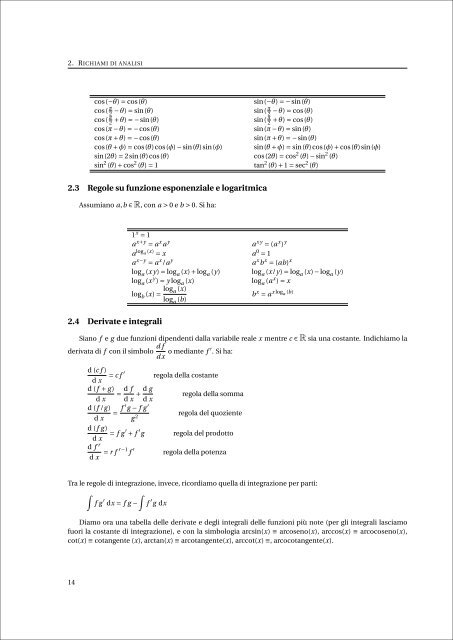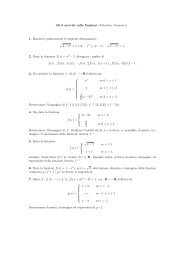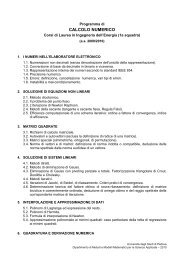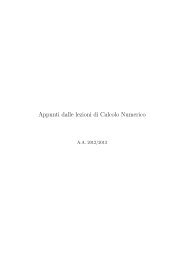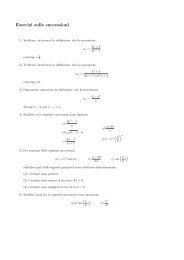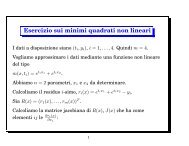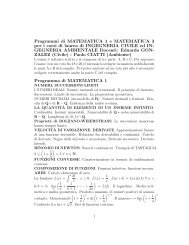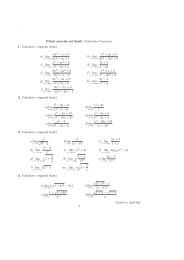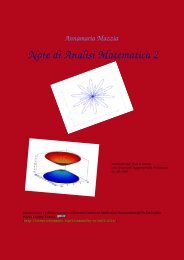Appunti di Calcolo Numerico - Esercizi e Dispense - Università degli ...
Appunti di Calcolo Numerico - Esercizi e Dispense - Università degli ...
Appunti di Calcolo Numerico - Esercizi e Dispense - Università degli ...
You also want an ePaper? Increase the reach of your titles
YUMPU automatically turns print PDFs into web optimized ePapers that Google loves.
2. RICHIAMI DI ANALISI<br />
cos(−θ) = cos(θ)<br />
cos( π 2<br />
− θ) = sin(θ)<br />
sin(<br />
cos( π 2<br />
+ θ) = −sin(θ)<br />
sin(<br />
cos(π − θ) = −cos(θ)<br />
cos(π + θ) = −cos(θ)<br />
cos(θ + φ) = cos(θ)cos(φ) − sin(θ)sin(φ)<br />
sin(2θ) = 2sin(θ)cos(θ)<br />
sin 2 (θ) + cos 2 (θ) = 1<br />
sin(−θ) = −sin(θ)<br />
π<br />
2<br />
− θ) = cos(θ)<br />
π<br />
2<br />
+ θ) = cos(θ)<br />
sin(π − θ) = sin(θ)<br />
sin(π + θ) = −sin(θ)<br />
sin(θ + φ) = sin(θ)cos(φ) + cos(θ)sin(φ)<br />
cos(2θ) = cos 2 (θ) − sin 2 (θ)<br />
tan 2 (θ) + 1 = sec 2 (θ)<br />
2.3 Regole su funzione esponenziale e logaritmica<br />
Assumiano a,b ∈ R, con a > 0 e b > 0. Si ha:<br />
1 x = 1<br />
a x+y = a x a y<br />
a x y = (a x ) y<br />
a log a (x) = x a 0 = 1<br />
a x−y = a x /a y<br />
a x b x = (ab) x<br />
log a (x y) = log a (x) + log a (y)<br />
log a (x/y) = log a (x) − log a (y)<br />
log a (x y ) = y log a (x)<br />
log a (a x ) = x<br />
log b (x) = log a (x)<br />
log a (b)<br />
b x = a x log a (b)<br />
2.4 Derivate e integrali<br />
Siano f e g due funzioni <strong>di</strong>pendenti dalla variabile reale x mentre c ∈ R sia una costante. In<strong>di</strong>chiamo la<br />
derivata <strong>di</strong> f con il simbolo d f<br />
d x o me<strong>di</strong>ante f ′ . Si ha:<br />
d (c f )<br />
d x = c f ′ regola della costante<br />
d (f + g )<br />
= d f<br />
d x d x + d g<br />
d x<br />
regola della somma<br />
d (f /g )<br />
= f ′ g − f g ′<br />
d x g 2<br />
regola del quoziente<br />
d (f g )<br />
= f g ′ + f ′ g<br />
d x<br />
regola del prodotto<br />
d f r<br />
d x = r f r −1 f ′ regola della potenza<br />
Tra le regole <strong>di</strong> integrazione, invece, ricor<strong>di</strong>amo quella <strong>di</strong> integrazione per parti:<br />
∫<br />
∫<br />
f g ′ dx = f g − f ′ g dx<br />
Diamo ora una tabella delle derivate e <strong>degli</strong> integrali delle funzioni più note (per gli integrali lasciamo<br />
fuori la costante <strong>di</strong> integrazione), e con la simbologia arcsin(x) ≡ arcoseno(x), arccos(x) ≡ arcocoseno(x),<br />
cot(x) ≡ cotangente (x), arctan(x) ≡ arcotangente(x), arccot(x) ≡, arcocotangente(x).<br />
14


